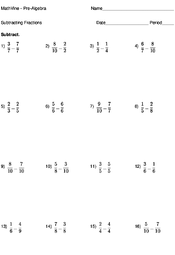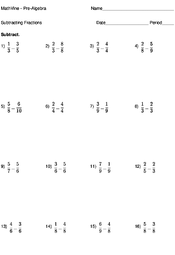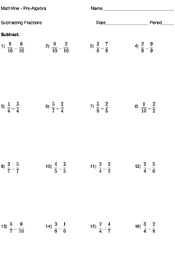Subtracting Fractions and Mixed Numbers
Introduction
In order to subtract fractions, we find the highest common factor of the denominator, and subtract one equivalent numerator from the other.
Terms
Lesson
When subtracting fractions, we have to make sure the denominators are the same. So if we are given in this case the denominators are the same, so we subtract 1 from 5 , which reduces to
When the denominators are different, we ‘make’ them the same by finding their least common multiple (LCM).
For example, in the problem , the LCM of 7 and 2 is 14
So to make the denominator of 6/7 = x/14, we have to multiply the denominator by 2 (don’t forget to multiply the numerator by 2 as well!). We then get . Similarly for 1/2, we multiply the numerator and denominator by 7 to get . The equivalent fractions of 6/7 (12/14) and 1/2 (7/14) now have the same denominators, so we simply subtract 7 from 12 to get 5/14.
When subtracting mixed fractions, we follow the same procedure but we need to convert the mixed fraction to an improper fraction first. So if we are given 1 2/3 – 1/4, we convert 1 2/3 to the improper fraction 5/3. Then we ‘make’ the denominators the same by finding the LCM, so we end up with . Since the denominators are now the same, we subtract 3 from 20 to get 17/12, or 1 5/12 (expressed as a mixed fraction).


